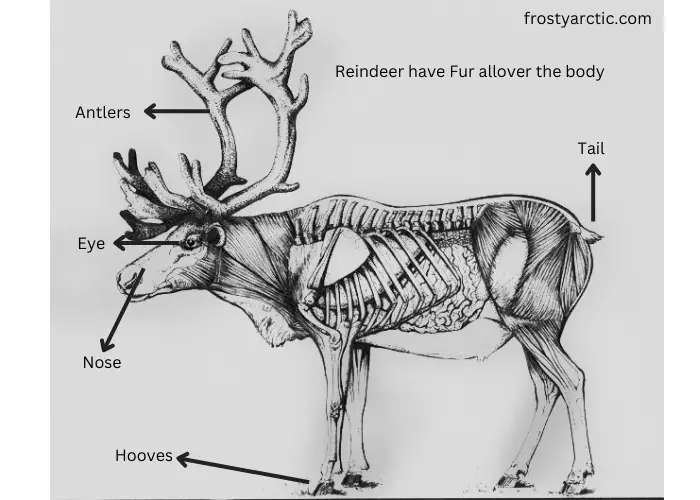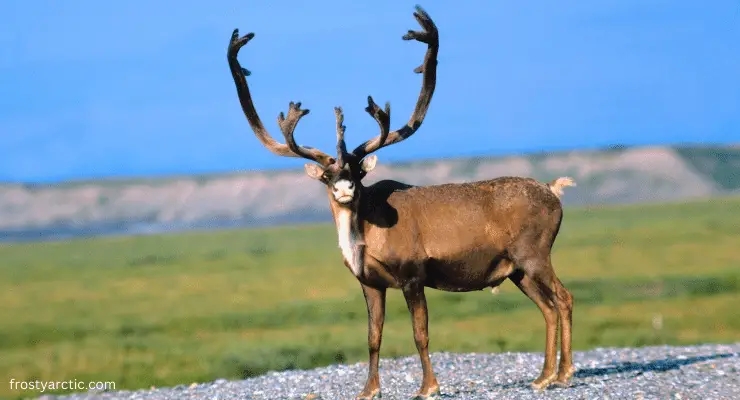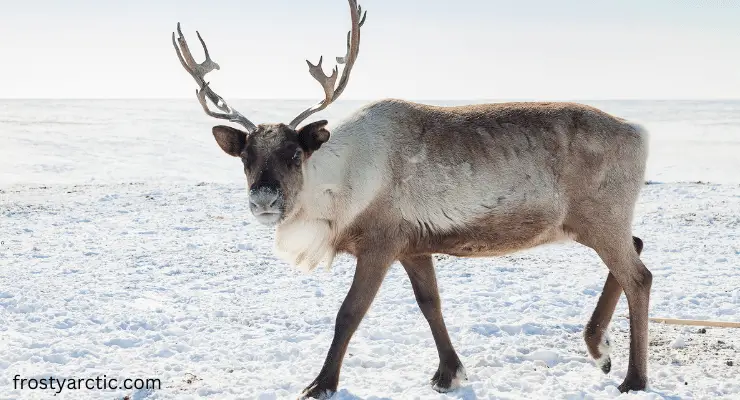A reindeer’s body is covered in fur, which keeps it warm in its extremely cold environment. Even the bottom of the reindeer’s hooves is covered in fur, which prevents them from slipping on ice ground. Their large, broad hooves also serve as effective paddles when the animal swims over rivers or lakes.
How have reindeer adapted to live, thrive, and survive in the extreme cold, where temperatures regularly dip below zero and the ground is covered in snow and ice? Let’s find out how reindeer can tolerate cold and harsh weather.
The Special Physical Characteristics of Reindeers for adaptations?

Reindeers have many special and unique characteristics for adaptations. Some of the important characteristics of reindeer are given below:
- Reindeer have fur-like hair on the body and head that helps insulate their bodies. This provides insulation to their skin and makes the reindeer warm in the extremely cold temperatures of their environment.
- Reindeer have hooves that help the animal dig through snow and ice. The hooves of reindeer grow as well as flatten and relax. This is because their feet have very tough pads and are well-suited to help them dig through the snow and ice that is their habitat.
- Reindeer have unique shaggy hair on the cheeks and jaw that help them keep warm in the winter.
- Reindeer have a low metabolic rate, which means they do not feel the cold as much as some other animals. This is due to their thick winter coat, thicker than an elephant and thick skin that protects their vital organs from cold weather.
- Reindeer have nostrils that open widely when the animals are sleeping and close when they are awake. This helps them breathe better and keeps the air inside their lungs cool.
These are some of the few reindeer adaptations that protect them against extreme cold weather.
Physical Adaptions: How Do Reindeer Adapt to the Environment with their Special Physical Characteristics?
Reindeer can endure the harsh Arctic climate and long, starvation-inducing winters because of various adaptations. In the Arctic, temperatures frequently drop below zero, and the landscape is covered in snow and ice.
A small population of forest reindeer lives in Finland. They are also present in Scotland due to a successful reintroduction in the Cairngorm Mountains.
This shows most of their population lives in extremely harsh and cold areas. So how exactly can a reindeer endure the bitter cold of the Arctic? There are various justifications for this, like antlers, nose, fur, vision, and many more.
Let’s explore how reindeer thrive in some of the most hostile Arctic regions on earth.
Here are some of the most unique ways reindeer have adapted to endure the brutally cold conditions of their environment:
1. Fur
During the coldest months of the year, tundra temperatures frequently range between -28°C and -18.4°F, with frequent extreme lows of -70°C and -94°F. In July and August, when they can reach as high as 16°C (60°F), temperatures are at their maximum.
The environment is hostile, and survival calls for particular adaptations. A shaggy top layer covers an incredibly fine and thick underfur on reindeer.
Insulation is provided by the outer hollow hairs, which resemble polar bear fur. It is so thick the tundra reindeer’s body temperature is very stable in cold temperatures.

2. Nose
Not only is the reindeer nose fuzzy, but it also undergoes an unusual internal warming process. To clarify, a reindeer’s breathing causes water vapor to condense before being released into the atmosphere because their breath is heated during inhalation and cooled during exhalation.
This keeps them warm and even gives their noses a Rudolph-like pinkish-red tint. The cilia inside the nostrils also help to warm up the air.
So, when reindeer breathe in, moisture is deposited into their nasal cavities that is warmed up and then blown through their nostrils to create this Pink nose effect.
Also, Reindeer have a well-developed sense of smell. They utilize this sense to help them detect carcasses and warn others of impending predators.
3. Antlers
The Arctic tundra lacks suitable soil layers like those seen in moderate temperate grassland, leaving only an active layer of permafrost that can support plant life. Also, the soil (known as Gelisol Soil) supports 1700 to 2,000 plant species (herbs and shrubs).
This dirt layer melts in the summer, allowing plant life to flourish. You will see greenery everywhere. The weather generates a cycle of melting and freezing. The active layer gets smaller and growth potential decreases as you travel further north.
The depth of tundra soil can range from 10 to 40 inches (25 to 100 cm). So, what’s the purpose of reindeer antlers here? Reindeer use their antlers to dig through the ground in search of food and scrape off the snow.
Reindeer antlers are among the largest among deer species, and they are special in that both male and female reindeer have them. To grow new antlers for the upcoming seasons and conditions they must endure, reindeer antlers shed their old antlers each year. Thus, reindeer antlers are specialized for finding prey.
4. Vision
There isn’t much sunshine in the northern tundra where reindeer live. Summer days are 24 hours long, although the sun is still low in the sky. As a result, it is referred to as the land of the midnight sun.
The opposite is true in the winter when the entire landscape is dark. Reindeer eyes are sensitive to ultraviolet light to see better and survive the long, dark Arctic winters.
Moreover, Reindeer have a good sense of hearing and vision and can detect the movement of predators at a distance through sound and movement. They may use vocalizations and warn others by the vibrations of their antlers. These physical adaptations help them to detect predators and adjust their behavior accordingly.
5. Bones
Just like the nose, the bones of reindeer also experience unusual internal warming during cold weather. This is because they generate more body heat through daily activities that rely heavily on their skeletal system.
Reindeer’s bones are so hard, they can absorb the heat from a fire and carry it through their bones, keeping them warm and making them excellent running reindeer.
6. Tendons and Hooves
Reindeer tendons and hooves also have special adaptations. When the muscles contract to move the legs, it presses on the surrounding tendons, turning their toes upward and making climbing easy.
This helps keep them from freezing to the ice, especially at night. Similarly, reindeer hooves are more flexible and thicker than other ungulates hooves. This makes it easy to get traction in ice and snow and helps them avoid stepping in a crevice.
The tendons of the reindeer’s foot joint click as it moves. In low visibility, these noises aid herds in maintaining their ties. They also have two toes with large, protruding claws attached.
They distribute their weight and offer traction with their hooves. Reindeer dig through the snow with their hooves in a technique known as cratering to find hidden food.
7. Eyes
Reindeer have special eyelids called “blue” eyes, which allow them to operate in freezing conditions. Some scientists believe a super cold environment forces them to close their eyelids for protection.
This is true because reindeer cannot blink like normal mammals, but reindeer can open their eyelids very wide on a bright day. That allows them to look at the sun even in direct sunlight. The cold minimizes the amount of light reaching their retinas, keeping their eyes as safe as possible.
All these ways in which the reindeer can adapt to the cold weather make them one of the toughest animals on Earth.
But this extreme environment also has its downside. Because reindeer spend most of their lives in remote areas far from civilization, they are very vulnerable to extreme weather. A single storm or an avalanche can wipe out entire herds, leaving them to die from starvation and exposure.
Reindeer Behavioral Adaptations: Reindeer Offensive Adaptations

The only ungulate species that has successfully inhabited arctic tundra habitats are reindeer. Despite facing comparable environmental restrictions, their morphological differences have allowed them to develop distinctive behavioral adaptations that, in most cases, lead to little overlap in the use of forage resources.
Due to their smaller bodies, reindeer must pursue selective eating, which necessitates high movement and energy expenditure levels. These species’ reactions to predators and insects display comparable disparities in the related energy costs.
Competition for food may arise when faced with environmental extremes that restrict the supply of forage, and the consequent unequal success is a reflection of their diverse evolutionary paths.
In general, extreme body weight is a significant behavioral adaptation, demonstrated by wolves, primates, and deer, which depends on adaptations to environmental variation and intense competition for food.
The energy requirements for reindeer to successfully maneuver around their environments, the assumption that reduced metabolism and increased endurance contribute to their adaptation is only partly true.
One hypothesis suggests that feeding behavior can change drastically regarding resource availability. Diet, nutritional quality, and dietary deficiencies affect behavior in mammals and have implications for the evolution of this species’ terrestrial and migratory behavior.
Reindeer behavioral adaptations, therefore, can be as closely linked to diet, physiology, and social behavior as their skeletal and physiological adaptations, allowing them to compete for food and survive in extreme environments.
With less food available, reindeer modify their behavior to seek and consume better food sources. Animals seeking food can survive and thrive if they expend more energy to perform that behavior.
The intensity of the behavior also affects the selection of energetic adaptations, which can have long-term effects on the population. Reindeers’ extreme and offensive feeding behaviors pose a particular threat to their survival and motivate their increased detection of predators and predatory responses, even in low populations.
The decrease in reindeer numbers within the arctic tundra region resulted in a period of ecological imbalance due to decreased summer grazing.
In response, reindeer individuals adapted their feeding and movement behavior to reduce their consumption of energy-rich vegetation but also modified their encounters with predators. Consequently, there are fewer predator encounters and smaller numbers of predators.
Along with this behavioral adaptation, it is observed that the population density of reindeer is negatively correlated with forage availability. When low in numbers, reindeer become even warier of predators.
In contrast, some reindeer are so fearful that they have evolved adaptive behaviors to increase their probability of survival in an environment that is growing increasingly inhospitable due to climate change.
Reindeer Food Adaptations
Reindeer are well-adapted to changes in the availability of food than humans are. They are more vulnerable to food availability changes and often succumb to their circumstances, even when they adjust their foraging behavior to use more energy to find nutritious food. Reindeer rely on their traditional food sources, which are gradually disappearing.
Food sources during the summer include grass, sedges, the new growth of larch, willow, and birch, as well as their green leaves.
In the late summer, mushrooms are sought after. Reindeer need moss, which they find by creating craters in the snow because their metabolism slows down in the winter and they need more carbohydrates.
The mother reindeer shares food with its calf. Since urea is often a waste product, the reindeer use their digestive system to recycle and utilize the nitrogen in urea to thrive on this low-protein diet.
Unlike males, who lose their antlers immediately after the rut, females retain their antlers throughout the winter, allowing them to protect feeding craters from both the males and other females.
a) Reindeer Lichen Adaptations
The fruticose (bushy branching) lichen known as reindeer lichen (Cladonia rangiferina), often known as reindeer moss, is widely distributed in Arctic regions.
Reindeer graze on the lichen, which covers vast northern tundra and taiga regions. Due to its sluggish growth, reindeer lichen is difficult to come by in Scandinavia, where it has been used to make alcohol. The term is also given to the lichen Cladonia portentosa, which is related.
It is speculated that during winter, reindeer consume lichen more often than other plant life. Reindeer richen adaptations vary. Some lichen species can survive in summer and even in light of snowfall.
On the other hand, some lichen species, such as Cladonia rangiferina, which is usually consumed by reindeer, cannot withstand sudden extremes of temperature. Reindeer are one of the only animals that can survive long periods of fasting without going into starvation.
b) Reindeer Moss Adaptations
Like other lichens, reindeer moss lacks any roots. Through cells on its surface, it can take nutrients and moisture from the air. However, this adaptability makes reindeer moss extremely vulnerable to environmental toxins.
Reindeer moss, like other lichens, absorbs a lot of the surrounding air, making it a useful indication of the quality of the environment.
When damp, it is springy and spongy; nevertheless, when there is minimal rain, it becomes dry and brittle and will crunch underfoot.
The plant dries out and goes dormant when there isn’t enough water. Even after a very long dormancy, reindeer moss can start to grow again.
Reindeer moss’s adaptability to environmental changes is extremely important for its survival. These are also dependent on the particular conditions the lichen is growing.
Some moss is very sensitive to changing environmental conditions and is prone to die if the environment becomes too cold. Some of these will perish when the temperatures get too low.
FAQ
Can Reindeer Handle the Heat?
Yes, reindeer can handle the heat. However, they are very sensitive to heat, especially on top of an exposed cliff or a tundra (a region of bare tundra that gets a lot of sunlight but not much heat). They love to live in moderate and a little bit cozy area.
They don’t like to be in extremely cold winters, high mountains, or icy environments. They prefer tundra (not barren land) in all those environments.
Their adaptations to heat and cold allow them to live in the sub-arctic. Reindeer is one of the world’s only mammals with this kind of versatile thermoregulation.
How Does Reindeer Lichen Survive?
Reindeer lichen has an extremely slow growth rate, making it possible to weather extreme climatic conditions. They are also tolerant of drought and even the coldest conditions and will put on weight regardless of how long they have been dormant.
They resist freezing and can withstand extreme cold, even in the deepest winter.
How Can Reindeer Go Without Food and Water for A Long Time And Remain Healthy And Alive?
This is a good question; like most of them, there is no single correct answer. Scientists studying lichen have reported that lichen has an incredibly wide range of mechanisms that enable them to survive extreme conditions. In addition, the optimal environmental conditions for growth will also depend on the species of lichen.
To begin with, it is worth pointing out that various levels of adaptation are possible in lichen. The most rudimentary level is called phototropic.
This means that lichen can use the light from the Sun or artificial light sources to grow and flower. Less-developed phototropic mechanisms are found in the genera Cladonia and Polypodium.
What Are Two Ways Reindeer Protecting Themselves Against Predators?
Reindeer use their antlers when they are avoiding a predator. In addition, they make noise with their feet so that their scent will also be masked.
However, with low visibility in the winter, reindeer have reduced hearing. This can lead to confrontation between predators and reindeer during the winter months.
Another way reindeer protects themselves from predators is through their large, powerful hooves, which allow them to run quickly. They have also been observed to move in herds, with the slower animals separating from the rest and hiding in the snow.
What do you know about Svalbard reindeer adaptations?
Svalbard reindeer’s main diet is lichen, and they are extremely adaptable to their natural surroundings and can tolerate environmental stress in many different ways.
Their bodies are shorter, stockier, and have smaller necks than other reindeer species, reducing their exposure to the weather.
They can survive in the worst conditions despite losing a third of their body weight in the winter thanks to their highly insulating fur, which has two layers:
- A soft and thick undercoat
- A topcoat of hollow and water-repellent guard hairs
In addition to making reindeer float, that hollow hair also makes them unusually good swimmers. Although they don’t have red-glowy noses, they possess a unique superpower that warms the air Svalbard reindeer breathe before it enters their lungs.
Conclusion
Reindeer are an adaptable species that can survive in extreme and harsh climates, allowing them to survive in places where others cannot. They possess large eye areas, double fur, flexible necks, and sensitive noses, making them useful predators and species that will notice many small, subtle environmental changes, such as signs of impending danger.



8 thoughts on “How Does a Reindeer Adapt to Its Environment?”